The fungus of the nails of the legs or onychomycosis is a common problem with which every person risks facing life, regardless of age or social status.This disease is accompanied by extremely unpleasant symptoms associated with aesthetic changes in nails and physiological discomfort.
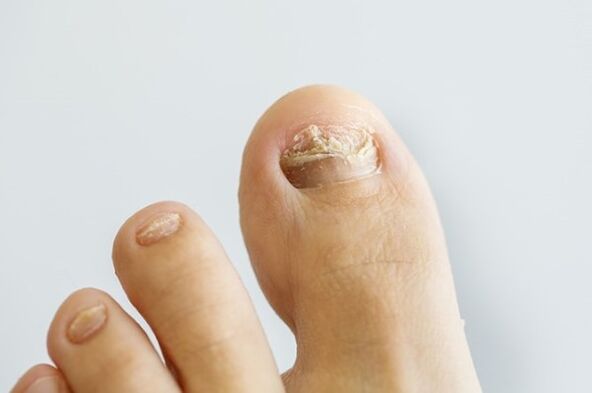
The causes of fungal nail damage
fungal damage to the nails on the legs in medical practice is much more common than a similar disease on the hands.This is due to the fact that the lower limbs are much more often in contact with the contaminated environment.In this case, the main cause of the occurrence is reduced immunity.The weakened organism is not able to fully resist an infectious agent.
If we talk specifically about the fungus on the nails of the legs, there are a number of factors that contribute to infection:
- Visiting public places without shoes.This is especially true for baths, saunas and pools, showers in gyms or in production, hospital departments in a hospital.In the first two cases, the risk of infection is high due to the attendance of such places by people who are carriers of fungal infection.In addition, mushrooms are more actively multiplying in a humid environment.Hospitals, despite compliance with sanitary standards, are a place of concentration of various infections, including fungal ones.Having become barefoot on the floor in one of these places, the probability of getting an infection grows ten times.
- In the absence of regular cleaning using aggressive chemistry, it also becomes a rod of fungal infection.Even if none of the domestic ones was ill with onychomycosis, conditionally pathogenic mushrooms that live on human skin multiply in the uncleaned bath.An increase in their population leads to deplorable consequences.
- Wearing old or other people's shoes-since conditionally pathogenic mushrooms are on the skin, their entering shoes (especially a closed type), inevitably.Microorganisms accumulate in the layers of tissue, which also increases the risk of infection.
- Wearing shoes is not seasoned - one of the factors of infection is excessive sweating of the legs.If a person walks in closed shoes in the summer or wears warm shoes in the room, the probability of fungal damage increases.
- Violation of legs hygiene - many people do not pay due attention to hygiene of the lower extremities.However, periodic cutting of nails and careless washing of the legs with soap may not be enough.It is important to cut the nails regularly, cut off the burrs and push the cuticles, use special lotions and constantly clean the keratinized layers of the skin.
- Injuries - we are talking about damage to the nail plate on the fingers during strikes, bruises, cuts.In such cases, blood circulation is disturbed in the damaged area, the nail does not receive the proper amount of nutrients.This can provoke the development of the fungus.
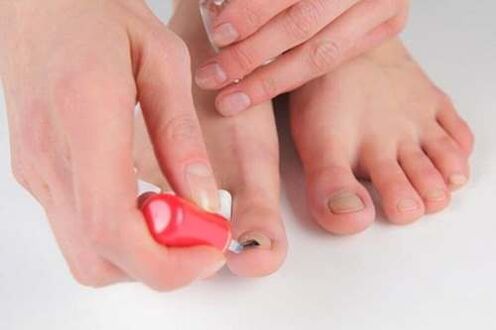
Types of mushrooms and features of damage to the nails on the legs
from the detection of the type of mushrooms that affect the nail plate, the features of treatment depend.This is explained by the possibility of selecting drugs that show activity in relation to a particular type of pathogen and the most effective treatment.
Dermatophytes
The most common type of pathogen.According to statistics, dermatophytes cause a fungus on the nails of about 75-80% of cases.It is in this case that the state of the immune system occupies the main role in the occurrence of onychomycosis.With normal immunity, fungal damage to dermatophytes is almost impossible.
Infection comes from people or animals that are carriers, as well as when contacting the soil.Ceratinocytes, cellular structures of the epidermis, the high content of which is observed in nails, are a favorite nutrition medium of this type of mushrooms.
In the caste of dermatophytes, two main subspecies are distinguished, most often aschomycosis pathogens:
- red trichophyte (Rubrum) - the beginning of the pathological process occurs on the end (external or free) part of the nail, from where the infection gradually moves to the root of the nail plate.In most cases, it is this subspecies that affects the toes.He is characterized by simultaneous damage to the nails on several fingers (often standing nearby).The characteristic signs of infection are the thickening of the affected area of the nail and its delamination.The skin under the outer facet of the nail plate dries and peels.
- Trichophyton intergracial - in this case, white surface onychomycosis develops.The favorite habitat of the subspecies is wet, it is often found in baths, baths, pools.The causative agent more often affects the thumbs of the lower extremities, after which it “captures” other nails.A characteristic feature is considered to be focal damage to the nail plate with the appearance of separate white spots or strips.In the future, whitish areas grow, merging together.When the fungal life forms are distributed to other fingers, areas of dried and peeling skin between the fingers are found.
Excellent
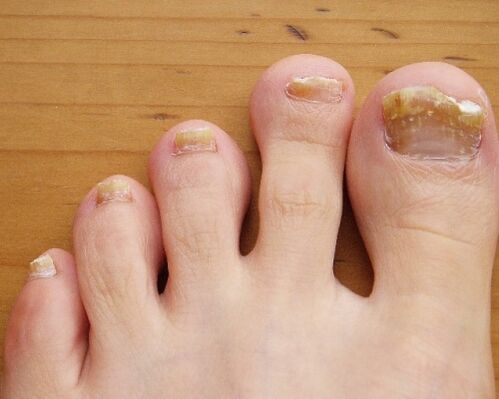
Another causative agent of fungal damage to the nails on the legs is conditionally pathogenic fungi from the Candida family.They are considered conventionally and pathogenic due to the fact that they constantly live on the surface of the human skin.That is, for infection, contact with an infected person, animal, or external environment does not need at all.In this case, the main trigger of the pathology is a significant decrease in immunity, immunodeficiency.
Unlike dermatophytes, yeast mushrooms do not form a layer of mycelium, that is, the destruction of the nail plate with this form of damage occurs much less often.But the same factor makes infectious lesion heavier, since the beginning of the pathological process takes on the root (proximal) side of the nail.Such varieties of mycosis are considered more severe, but at the same time rare.
The first characteristic feature of the pathological process caused by yeast mushrooms is the detachment of the upper layer of the nail plate.Because of this, the nail loses its luster, becomes dull and rough.The damage to the nails of the legs with yeast mushrooms occurs in approximately 7-10% of cases.
Mold
The most insidious type of mushrooms, since these forms of life are found almost everywhere (but especially in a humid environment).The fungal damage to the nail on the leg can cause about 35-40 subspecies of molds.
Despite the prevalence in the environment, this form of onychomycosis is rarely diagnosed.In part, therefore, as well as due to an atypical clinical picture, mold is more difficult to diagnose and treat.Another reason for the complexity of the diagnosis of mold onychomycosis is the ability of mold mushrooms to form mycelium, which makes the clinical picture a draw with damage to dermatophytes.
The fungal life forms of life affects mainly nails on the legs, and the infection of the subspecies is about 10-15%.
Clinical picture
Most types of fungal damage to the nail plates progress slowly.At the initial stages, the fungus can remain unnoticed at all.But still there are symptoms of the early stages of the development of pathology, which it is important to pay attention to:
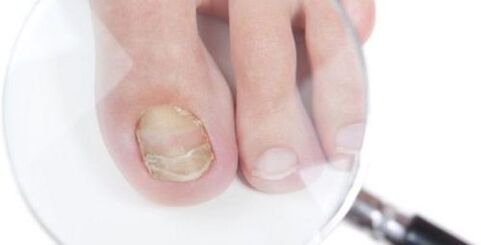
- Growth violation is the first and most inconspicuous sign.In a state of norm, the nail on the leg grows by no more than 2 mm per week.The nail plate, which is affected by the fungus, slows down the growth rate.
- Color change - first of all, the nails affected by the fungus are fading, losing her linen, becoming matte.It also notes the appearance of white or yellow interspersed on the surface of the nail or a complete change in the color of the nail plate (white, yellow or shades of brown are possible).Changing the color of the nail fungus in the photo above.
- The formation of burrs and damage to the cuticle is another indirect feature indicating the infection with the fungus of nearby skin.If the burrs began to appear more often, and the cuticle zone is systematically inflamed or damaged, it is worth it to check for fungal damage.
- Thickening or thinning of the nail plate - variations depend on the lesion of specific types of mushrooms.
As the pathological process progresses, the symptoms become more obvious, it is more difficult to ignore it.The clinical signs of later stages of onychomycosis include:
- changing the surface of the nail plate - it becomes rough and uneven, dotted with tubercles and waves.Also, similarities of crumbs may appear on the nail, which indicates a gradual detachment of the upper layer of the nail.
- In the even later stages, the nail gradually begins to collapse.Initially, this is expressed in the stratification of the nail plate, the appearance of cracks on the entire surface or chips at the outer edge.This is what this feature of the fungus on the nails of the legs in the photo looks like.
- In the future, destruction becomes even more severe.The nail literally crumble, not having time to grow.At the same time, the sub -gear sections of the dermis are exposed, and the remaining parts of the nail look clearly painful and unattractive.As a result, there is a risk of complete destruction or detachment of the nail plate.Severe lesion with a fungus of the nail in the photo above.
The danger of complications
A mass of unpleasant sensations and the deterioration of the appearance of the nails of the legs is only the top of the iceberg.The absence of timely treatment threatens the development of complications, among which the most common are:
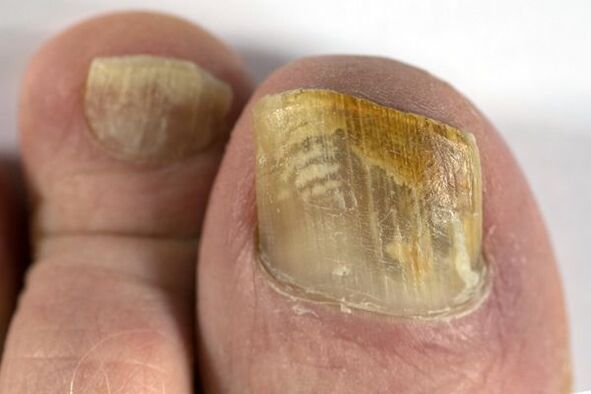
- allergic reactions - at certain stages of development of the legs, the body fungus can be perceived by the body as an allergen.
- Fungal damage can weaken the immune system of the body, provoke the development or progression of a number of diseases, including the treatment of onychomycosis, it makes it possible to join other infections on the affectedareas.As a result, inflammatory and purulent processes develop.
- Particularly severe cases, subject to a long course and progression of the disease, can lead to the development of fungal mycosis.In this case, fungal life forms can penetrate the blood and will be spaced throughout the body.
- Treatment methods
For the maximum effectiveness of the treatment of nail fungus, complex therapy is often used.At the same time, it is previously important to conduct diagnostics by sowing on a bacterial environment in order to determine the type of pathogen and choose the most effective drugs.The integrated approach involves the combination of several types of therapy, but sometimes this is not enough.
Medication
Medication therapy is the basis for the treatment of most pathologies, including fungal nail damage.As part of the treatment, two main groups of medication are used, depending on the stage of development of the pathological process:
- Local type of action - these include ointments, gels, varnishes, creams, sprays and lotions with antifungal activity.The method, multiplicity and duration of the use of such drugs is determined by a doctor, but in most cases they are used at least 2-3 weeks.
- Systemic antimicotics are necessary for the treatment of nail fungus at later stages of progression.For the most part, these are tablets, which, after sucking from the gastrointestinal tract, penetrate the blood and inhibit fungal life forms, and also does not allow mycosis to spread.The use of systemic remedies is important not only to enhance the therapeutic effect, but also in order to prevent relapse.
Popular media
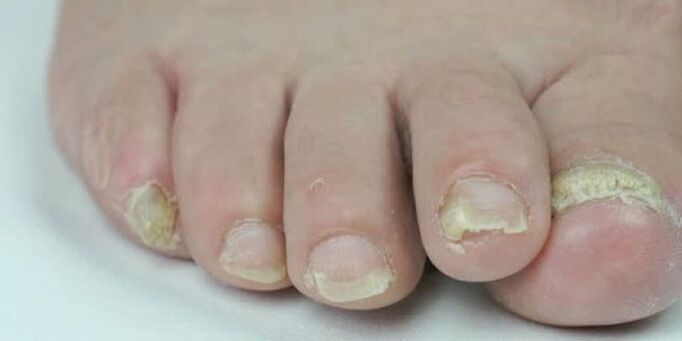
People's medicine is considered an auxiliary method of combating fungus on the legs.Folk recipes can enhance the antifungal effect.The most effective of them are:
- iodine - is able to dissolve protein structures, which are the basis of fungal life forms.For treatment daily, apply a few drops of iodine to the affected areas using a cotton pad. Oxide is an effective antibacterial agent that has a disinfectant effect.To enhance the effect, the peroxide is mixed in equal proportions with vinegar.Then the patient is lubricated with a mixture, it is not necessary to rinse it.The procedure is repeated daily for 1-2 weeks.
- Celandine-the best method of using this plant for the treatment of fungus on the nails of the legs is poultice.To do this, take a tablespoon of crushed raw materials (leaves and twigs), pour 0.5 liters of water and bring to a boil.The decoction is defended within 15-20 minutes, after which the legs are plunged into it for another 20-25 minutes.Repeat the procedure daily before bedtime for 2-3 weeks.
Removing the nail
Today in medical practice, mainly the chemical method of removing the nail plate - avulces is used.For this, special aggressive drugs are used, the procedure is carried out by a doctor so as not to harm healthy areas of the nail plate and skin.This method is painless and effective, and the indications for its use are the absence of the results of conservative treatment or advanced cases of onychomycosis.
Laser therapy
The procedure involves partial or complete removal of the nail plate.The choice of the method depends on how deeply the fungus penetrated the structure of the nail.In the course of laser therapy, an intensive laser irradiation method is used.A special apparatus is removed with a fungus layers of the nail, after which the course of antifungal therapy follows.

Full removal of the nail plate with a laser is necessary if the nail is affected by the fungus completely, to the base.In this case, after removal, a bandage is applied to the bare areas of the skin, under which an ointment or cream with an antifungal effect can be laid.Removing the nail plate requires regular visits to the doctor in order to carry out dressings and track the growth of the new nail plate.
Laser treatment of nail fungus on the legs, during which only a few layers of the nail is removed, is carried out in stages within 7-10 procedures (for the treatment of each nail, it takes about 10-15 minutes).If the removal is shown, the procedure goes away and takes about 20 minutes, the patient does not feel pain.

















